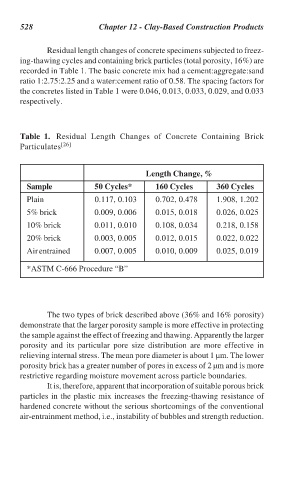Page 558 - Handbook of Thermal Analysis of Construction Materials
P. 558
528 Chapter 12 - Clay-Based Construction Products
Residual length changes of concrete specimens subjected to freez-
ing-thawing cycles and containing brick particles (total porosity, 16%) are
recorded in Table 1. The basic concrete mix had a cement:aggregate:sand
ratio 1:2.75:2.25 and a water:cement ratio of 0.58. The spacing factors for
the concretes listed in Table 1 were 0.046, 0.013, 0.033, 0.029, and 0.033
respectively.
Table 1. Residual Length Changes of Concrete Containing Brick
Particulates [26]
Length Change, %
Sample 50 Cycles* 160 Cycles 360 Cycles
Plain 0.117, 0.103 0.702, 0.478 1.908, 1.202
5% brick 0.009, 0.006 0.015, 0.018 0.026, 0.025
10% brick 0.011, 0.010 0.108, 0.034 0.218, 0.158
20% brick 0.003, 0.005 0.012, 0.015 0.022, 0.022
Air entrained 0.007, 0.005 0.010, 0.009 0.025, 0.019
*ASTM C-666 Procedure “B”
The two types of brick described above (36% and 16% porosity)
demonstrate that the larger porosity sample is more effective in protecting
the sample against the effect of freezing and thawing. Apparently the larger
porosity and its particular pore size distribution are more effective in
relieving internal stress. The mean pore diameter is about 1 µm. The lower
porosity brick has a greater number of pores in excess of 2 µm and is more
restrictive regarding moisture movement across particle boundaries.
It is, therefore, apparent that incorporation of suitable porous brick
particles in the plastic mix increases the freezing-thawing resistance of
hardened concrete without the serious shortcomings of the conventional
air-entrainment method, i.e., instability of bubbles and strength reduction.

